Wildfire Risk Levels at the Local Scale: Assessing the Relative Influence of Hazard, Exposure, and Social Vulnerability
Abstract
1. Introduction
2. Materials and Methods
2.1. Study Area
2.2. Methodology
2.2.1. Wildfire Hazard
2.2.2. Exposure
2.2.3. Social Vulnerability
2.2.4. Wildfire Risk Index
2.2.5. Cluster Analysis
3. Results
3.1. The Dimensions of Wildfire Risk
3.2. Wildfire Risk Index
3.3. Risk Profiles and Cluster Analysis
4. Discussion
5. Conclusions
Author Contributions
Funding
Institutional Review Board Statement
Informed Consent Statement
Data Availability Statement
Conflicts of Interest
Appendix A
| Variable | Relation to Criticality |
|---|---|
| Illiteracy rate (%) | Education is linked to socioeconomic status, with higher educational attainment resulting in greater lifetime earnings. Lower education constrains the ability to understand warning information and access to recovery information [29,32,64]. |
| Proportion of the resident population with university degree (%) | |
| School dropout rate (%) | |
| Proportion of socially more valued professionals (%) | Socially valued professions are associated with higher income and education level and are likely to be associated with a greater capacity to resist and recover from wildfire events. |
| Proportion of single-member families constituted by people with 65 or more years of age (%) | Extremes of the age spectrum affect the movement out of harm’s way. Parents lose time and money caring for children when daycare facilities are affected; elderly may have mobility constraints or mobility concerns increasing the burden of care and lack of resilience [32,64]. |
| Mean age of resident population (years) | |
| Proportion of the resident population with 14 or less years of age (%) | |
| Proportion of lodgings formed by couples with children (%) | Families with children will have to allocate time and resources to care for them, which may affect their resilience and capacity to recover from hazards. |
| Mean commuting time of the working or studying resident population (min) | The greater the amount of time a resident is absent from home on a regular basis, the less likely is he/she to be able to react quickly in case of wildfire, and the more difficult will be the recovery. This will be especially acute in the case of seasonally used homes. |
| Proportion of the resident population working or studying in another municipality (%) | |
| Proportion of seasonally used classic family lodgings (%) | |
| Proportion of the resident population that resided in another municipality 5 years before (%) | New residents and foreign nationals will be less likely to have established consolidated networks of social connections, and thus be less likely to benefit from help from neighbours and more likely to be unaware of warning information. In the case of foreigners, the language barrier may constrain disaster preparedness and resilience [29], and cultural barriers may affect access to post-disaster relief initiatives. |
| Proportion of the resident population of foreign nationality (%) | |
| Female activity rate (%) | Women can have a more difficult time during recovery than men, often due to sector-specific employment, lower wages, and family care responsibilities [32]. |
| Female proportion of the population (%) | |
| Proportion of self-owned lodgings that include expenses (%) | Home expenses can be a major component of the household budget and impact the capacity to invest in resilience prior to a disaster, as well as the capacity to recover from it. |
| Proportion of family lodgings lacking at least one basic infrastructure (%) | The quality of residential construction affects potential losses and recovery [32]. Older buildings, those lacking basic infrastructures, or mobile or improvised habitations are likely to be more vulnerable to the effects of wildfire [29]. |
| Average age of buildings (years) | |
| Proportion of buildings built within the previous ten years (%) | |
| Proportion of non-classical lodgings (%) | |
| Proportion of rented or subleased classic lodgings (%) | People that rent do so because they are either transient or do not have the financial resources for home ownership. They often lack access to information about financial aid during recovery. In the most extreme cases, renters lack sufficient shelter options when lodging becomes uninhabitable or too costly to afford [32]. |
| Proportion of single-lodging buildings (%) | People in rural areas tend to have limited access to emergency and contingency-related resources, good and services. Their rehabilitation potential is also reduced compared to urban areas [56]. |
| Proportion of overcrowded lodgings (%) | Overcrowding may be associated with financial constraints, also making evacuation more difficult [29,64]. |
| Floors by building (Nº) | High-density areas (urban) complicate evacuation in case of disaster [29,32]. |
| Proportion of the population using automobile for dislocations (%) | Residents with access to automobiles will be more mobile, which will facilitate getting out of harm’s way [29], as well as the capacity to recover from a wildfire. |
| Variable | Rationale |
|---|---|
| Ageing ratio of buildings (%) | Infrastructure that is old or degraded will likely be more vulnerable to wildfire damage, while possibly constraining the efficiency of response on the part of authorities. Additionally, the state and age of constructions is an indicator of the economic health of a parish (see economic indicators below). |
| Proportion of buildings in need of major reparations or very degraded (%) | |
| Proportion of buildings having wheelchair accessibility (%) | An indicator of the capacity of residents with impaired mobility to efficiently evacuate in case of wildfire, either with or without assistance. |
| Proportion of the resident population living outside of urban centres (%) | Population that is dispersed across the parish territory will likely be harder to assist by authorities in the case of disaster. Additionally, rural residents may be more vulnerable due to lower incomes and more dependent on locally based resource extraction economies [32]. |
| Road network density (km/km2) | The greater the number of corporations and firefighters, the greater the capacity of authorities to respond in case of wildfire [36]. Road density will promote overall accessibility, and therefore promote the efficiency of this response [36]. High road density will also facilitate evacuation in case of disaster. |
| Firefighter corporations (Nº) | |
| Firefighters (Nº) | |
| Pharmacies and mobile pharmaceutical posts (Nº) | The number of nurses and pharmacies are likely indicators of the overall capacity for efficient medical response in case of wildfire, decreasing its impacts and promoting recovery. |
| Nurses by workplace (Nº) | |
| Rooms in tourist accommodation establishments (Nº) | All these variables were adopted as indicators of overall economic health and vitality of parishes. Wealth enables communities to absorb and recover from losses more quickly due to insurance, social safety nets, and entitlement programs [32,64]. |
| Urban waste collected by inhabitant (kg) | |
| Gross Value Added of enterprises (EUR) (note: does not include financial sector) | |
| Median sale value by m2 of family accommodations | |
| ATM machines (Nº) |
References
- Ager, A.A.; Palaiologou, P.; Evers, C.R.; Day, M.A.; Barros, A.M.G. Assessing Transboundary Wildfire Exposure in the Southwestern United States. Risk Anal. 2018, 38, 2105–2127. [Google Scholar] [CrossRef]
- Alcasena, F.J.; Ager, A.A.; Bailey, J.D.; Pineda, N.; Vega-García, C. Towards a comprehensive wildfire management strategy for Mediterranean areas: Framework development and implementation in Catalonia, Spain. J. Environ. Manag. 2019, 231, 303–320. [Google Scholar] [CrossRef] [PubMed]
- Andersen, L.M.; Sugg, M.M. Geographic multi-criteria evaluation and validation: A case study of wildfire vulnerability in Western North Carolina, USA following the 2016 wildfires. Int. J. Disaster Risk Reduct. 2019, 39, 101123. [Google Scholar] [CrossRef]
- Antunes, C.C.; Xavier, D.; Manuel, J. Avaliação do Risco de Incêndio Florestal no Concelho de Arganil. Silva Lusit. 2011, 19, 165–179. [Google Scholar]
- Bergonse, R.; Oliveira, S.; Gonçalves, A.; Nunes, S.; da Câmara, C.; Zêzere, J.L. A combined structural and seasonal approach to assess wildfire susceptibility and hazard in summertime. Nat. Hazards 2021, 106, 2545–2547. [Google Scholar] [CrossRef]
- Bergonse, R.; Oliveira, S.; Zêzere, J.L.; Moreira, F.; Ribeiro, P.F.; Leal, M.; Lima e Santos, J.M. Biophysical controls over fire regime properties in Central Portugal. Sci. Total Environ. 2022, 810, 152314. [Google Scholar] [CrossRef] [PubMed]
- Boer, M.M.; Resco de Dios, V.; Bradstock, M.A. Unprecendented burn area of Australian mega forest fires. Nat. Clim. Change 2020, 10, 170. [Google Scholar] [CrossRef]
- De Brito, R.S. (Ed.) Atlas de Portugal, 1st ed.; Instituto Geográfico Português: Lisbon, Portugal, 2005. [Google Scholar]
- Calkin, D.E.; Thompson, M.P.; Finney, M.A.; Hyde, K.D. A real-time Risk Assessment tool supporting wildland fire decisionmaking. J. For. 2011, 109, 274–280. [Google Scholar] [CrossRef]
- Cardona, O.; Carreño, M.L. Updating the Indicators of Disaster Risk and Risk Management for the Americas. J. Integr. Disaster Risk Manag. 2011, 1, 27–47. [Google Scholar] [CrossRef]
- Cardona, O.D.; Van Aalst, M.K.; Birkmann, J.; Fordham, M.; Mc Gregor, G.; Rosa, P.; Pulwarty, R.S.; Schipper, E.L.F.; Sinh, B.T.; Décamps, H.; et al. Determinants of risk: Exposure and vulnerability. In Managing the Risks of Extreme Events and Disasters to Advance Climate Change Adaptation: Special Report of the Intergovernmental Panel on Climate Change; Cambridge University Press: Cambridge, UK, 2012; pp. 65–108. [Google Scholar] [CrossRef]
- Chas-Amil, M.L.; García-Martínez, E.; Touza, J. Iberian Peninsula October 2017 wildfires: Burned area and population exposure in Galicia (NW of Spain). Int. J. Disaster Risk Reduct. 2020, 48, 101623. [Google Scholar] [CrossRef]
- Chen, W.; Cutter, S.L.; Emrich, C.T.; Shi, P. Measuring social vulnerability to natural hazards in the Yangtze River Delta region, China. Int. J. Disaster Risk Sci. 2013, 4, 169–181. [Google Scholar] [CrossRef]
- Chuvieco, E.; Aguado, I.; Yebra, M.; Nieto, H.; Salas, J.; Martín, M.P.; Vilar, L.; Martínez, J.; Martín, S.; Ibarra, P.; et al. Development of a framework for fire risk assessment using remote sensing and geographic information system technologies. Ecol. Model. 2010, 221, 46–58. [Google Scholar] [CrossRef]
- Chuvieco, E.; Martínez, S.; Román, M.V.; Hantson, S.; Pettinari, M.L. Integration of ecological and socio-economic factors to assess global vulnerability to wildfire. Glob. Ecol. Biogeogr. 2014, 23, 245–258. [Google Scholar] [CrossRef]
- Cutter, S.L.; Boruff, B.J.; Shirley, W.L. Social vulnerability to environmental hazards. Soc. Sci. Q. 2003, 84, 242–261. [Google Scholar] [CrossRef]
- De Groeve, T. Index for Risk Management—INFORM; JRC Scientific and Policy Reports; Joint Research Centre, European Commission: Ispra, Italy, 2015; Volume 53. [Google Scholar] [CrossRef]
- Duguy, B.; Alloza, J.A.; Baeza, M.J.; De La Riva, J.; Echeverría, M.; Ibarra, P.; Llovet, J.; Cabello, F.P.; Rovira, P.; Vallejo, R.V. Modelling the ecological vulnerability to forest fires in mediterranean ecosystems using geographic information technologies. Environ. Manag. 2012, 50, 1012–1026. [Google Scholar] [CrossRef]
- Evers, C.R.; Ager, A.A.; Nielsen-Pincus, M.; Palaiologou, P.; Bunzel, K. Archetypes of community wildfire exposure from national forests of the western US. Landsc. Urban Plan. 2019, 182, 55–66. [Google Scholar] [CrossRef]
- Flanagan, B.E.; Gregory, E.W.; Hallisey, E.J.; Heitgerd, J.L.; Lewis, B. A Social Vulnerability Index for Disaster Management. J. Homel. Secur. Emerg. Manag. 2011, 8, 33–42. [Google Scholar] [CrossRef]
- Garcia, R.A.C.; Oliveira, S.C.; Zêzere, J.L. Assessing population exposure for landslide risk analysis using dasymetric cartography. Nat. Hazards Earth Syst. Sci. 2016, 16, 2769–2782. [Google Scholar] [CrossRef]
- Gómez-González, S.; Ojeda, F.; Fernandes, P.M. Portugal and Chile: Longing for sustainable forestry while rising from the ashes. Environ. Sci. Policy 2018, 81, 104–107. [Google Scholar] [CrossRef]
- Haynes, K.; Short, K.; Xanthopoulos, G.; Viegas, D.X.; Ribeiro, L.M.; Blanchi, R. Wildfires and WUI Fire Fatalities. In Encyclopedia of Wildfires and Wildland-Urban Interface (WUI) Fires; Manzello, S., Ed.; Springer: Berlin/Heidelberg, Germany, 2020; pp. 1073–1088. [Google Scholar] [CrossRef]
- Lee, S. Application of likelihood ratio and logistic regression models to landslide susceptibility mapping using GIS. Environ. Manag. 2004, 34, 223–232. [Google Scholar] [CrossRef]
- Leuenberger, M.; Parente, J.; Tonini, M.; Pereira, M.G.; Kanevski, M. Wildfire susceptibility mapping: Deterministic vs. stochastic approaches. Environ. Model. Softw. 2018, 101, 194–203. [Google Scholar] [CrossRef]
- Marques, S.; Borges, J.G.; Garcia-Gonzalo, J.; Moreira, F.; Carreiras, J.M.B.; Oliveira, M.M.; Cantarinha, A.; Botequim, B.; Pereira, J.M.C. Characterization of wildfires in Portugal. Eur. J. For. Res. 2011, 130, 775–784. [Google Scholar] [CrossRef]
- Mendes, J.M.; Tavares, A.O.; Cunha, L.; Freiria, S. A vulnerabilidade social aos perigos naturais e tecnológicos em Portugal. Social Vulnerability to Natural and Technological Hazards in Portugal. La vulnérabilité sociale face aux risques naturels et technologiques au Portugal. Rev. Crítica De Ciências Sociais 2011, 93, 95–128. [Google Scholar] [CrossRef]
- Mendes, J.M.; Tavares, A.O.; Santos, P.P. Social vulnerability and local level assessments: A new approach for planning. Int. J. Disaster Resil. Built Environ. 2019, 11, 15–43. [Google Scholar] [CrossRef]
- Mitsopoulos, I.; Mallinis, G.; Arianoutsou, M. Wildfire Risk Assessment in a Typical Mediterranean Wildland–Urban Interface of Greece. Environ. Manag. 2014, 55, 900–915. [Google Scholar] [CrossRef]
- Nauslar, N.J.; Abatzoglou, J.T.; Marsh, P.T. The 2017 north bay and southern california fires: A case study. Fire 2018, 1, 18. [Google Scholar] [CrossRef]
- Oliveira, S.; Félix, F.; Nunes, A.; Lourenço, L.; Laneve, G.; Sebastián-López, A. Mapping wildfire vulnerability in Mediterranean Europe. Testing a stepwise approach for operational purposes. J. Environ. Manag. 2018, 206, 158–169. [Google Scholar] [CrossRef]
- Oliveira, S.; Gonçalves, A.; Benali, A.; Sá, A.; Zêzere, J.L.; Pereira, J.M. Assessing risk and prioritizing safety interventions in human settlements affected by large wildfires. Forests 2020, 11, 859. [Google Scholar] [CrossRef]
- Oliveira, S.; Gonçalves, A.; Zêzere, J.L. Reassessing wildfire susceptibility and hazard for mainland Portugal. Sci. Total Environ. 2020, 762, 143121. [Google Scholar] [CrossRef]
- Oliveira, S.; Zêzere, J.L. Assessing the biophysical and social drivers of burned area distribution at the local scale. J. Environ. Manag. 2020, 264, 110449. [Google Scholar] [CrossRef]
- Oliveira, S.; Zêzere, J.L.; Queirós, M.; Pereira, J.M. Assessing the social context of wildfire-affected areas. The case of mainland Portugal. Appl. Geogr. 2017, 88, 104–117. [Google Scholar] [CrossRef]
- Pahl Consulting; IGOT. Metodologia Para a Produção de Carta de Perigosidade de Incêndio Rural de cariz Estrutural—Relatório Definitivo. 2020. Available online: https://www.icnf.pt/api/file/doc/96bb210ebf341cda (accessed on 13 September 2022).
- Palaiologou, P.; Ager, A.A.; Nielsen-Pincus, M.; Evers, C.R.; Day, M.A. Social vulnerability to large wildfires in the western USA. Landsc. Urban Plan. 2019, 189, 99–116. [Google Scholar] [CrossRef]
- Paprotny, D.; Morales-Nápoles, O.; Jonkman, S.N. HANZE: A pan-European database of exposure to natural hazards and damaging historical floods since 1870. Earth Syst. Sci. Data 2017, 2013, 1–25. [Google Scholar] [CrossRef]
- Parente, J.; Pereira, M.G. Structural fire risk: The case of Portugal. Sci. Total Environ. 2016, 573, 883–893. [Google Scholar] [CrossRef]
- Parisien, M.A.; Dawe, D.A.; Miller, C.; Stockdale, C.A.; Armitage, O.B. Applications of simulation-based burn probability modelling: A review. Int. J. Wildland Fire 2019, 28, 913–926. [Google Scholar] [CrossRef]
- Paveglio, T.B.; Abrams, J.; Ellison, A. Developing Fire Adapted Communities: The Importance of Interactions Among Elements of Local Context. Soc. Nat. Resour. 2016, 29, 1246–1261. [Google Scholar] [CrossRef]
- Paveglio, T.B.; Edgeley, C.M.; Stasiewicz, A.M. Assessing influences on social vulnerability to wildfire using surveys, spatial data and wildfire simulations. J. Environ. Manag. 2018, 213, 425–439. [Google Scholar] [CrossRef]
- Pereira, J.M.C.; Carreiras, J.M.B.; Silva, J.M.N.; Vasconcelos, M.J. Alguns Conceitos Básicos sobre os Fogos Rurais em Portugal. In Incêndios Florestais em Portugal: Caracterização, Impactes e Prevenção; Pereira, J.S., Pereira, J.M.C., Rego, F.C., Silva, J.M.N., Silva, T.P., Eds.; ISAPress: Lisbon, Portugal, 2006; pp. 133–161. [Google Scholar]
- Pereira, M.G.; Malamud, B.D.; Trigo, R.M.; Alves, P.I. The history and characteristics of the 1980-2005 Portuguese rural fire database. Nat. Hazards Earth Syst. Sci. 2011, 11, 3343–3358. [Google Scholar] [CrossRef]
- Pereira, M.G.; Trigo, R.M.; Da Camara, C.C.; Pereira, J.M.C.; Leite, S.M. Synoptic patterns associated with large summer forest fires in Portugal. Agric. For. Meteorol. 2005, 129, 11–25. [Google Scholar] [CrossRef]
- Pereira, S.; Santos, P.P.; Zêzere, J.L.; Tavares, A.O.; Garcia, R.A.C.; Oliveira, S.C. A landslide risk index for municipal land use planning in Portugal. Sci. Total Environ. 2020, 735, 139463. [Google Scholar] [CrossRef]
- Rodríguez y Silva, F.; Molina Martínez, J.R.; Herrera Machuca, M.; Zamora Diaz, R. Vulnerabilidad socioeconómica de los espacios forestales frente al impactode los incendios, aproximación metodológica mediante sistemas de informacióngeográficos (proyecto Firemap). In Proceedings of the IV International Wildland Fire Conference, Sevilla, Spain, 13–17 May 2007. [Google Scholar]
- Román, M.V.; Azqueta, D.; Rodrígues, M. Methodological approach to assess the socio-economic vulnerability to wildfires in Spain. For. Ecol. Manag. 2013, 294, 158–165. [Google Scholar] [CrossRef]
- Salis, M.; Ager, A.A.; Arca, B.; Finney, M.A.; Bacciu, V.; Duce, P.; Spano, D. Assessing exposure of human and ecological values to wildfire in Sardinia, Italy. Int. J. Wildland Fire 2013, 22, 549–565. [Google Scholar] [CrossRef]
- Salis, M.; Del Giudice, L.; Arca, B.; Ager, A.A.; Alcasena-Urdiroz, F.; Lozano, O.; Bacciu, V.; Spano, D.; Duce, P. Modeling the effects of different fuel treatment mosaics on wildfire spread and behavior in a Mediterranean agro-pastoral area. J. Environ. Manag. 2018, 212, 490–505. [Google Scholar] [CrossRef] [PubMed]
- San-Miguel-Ayanz, J.; Durrant, T.; Boca, R.; Libertá, G.; Branco, A.; de Rigo, D.; Ferrari, D.; Maianti, P.; Vivancos, T.A.; Lana, F.; et al. Forest Fires in Europe, Middle East and North Africa 2017; EUR 29318 EN; Joint Research Centre, European Commission: Ispra, Italy, 2018. [Google Scholar] [CrossRef]
- San-Miguel-Ayanz, J.; Moreno, J.M.; Camia, A. Analysis of large fires in European Mediterranean landscapes: Lessons learned and perspectives. For. Ecol. Manag. 2013, 294, 11–22. [Google Scholar] [CrossRef]
- Santos, P.P.; Pereira, S.; Zêzere, J.L.; Tavares, A.O.; Reis, E.; Garcia, R.A.C.; Oliveira, S.C. A comprehensive approach to understanding flood risk drivers at the municipal level. J. Environ. Manag. 2020, 260, 110127. [Google Scholar] [CrossRef]
- Schmidtlein, M.C.; Deutsch, R.C.; Piegorsch, W.W.; Cutter, S.L. A sensitivity analysis of the social vulnerability index. Risk Anal. 2008, 28, 1099–1114. [Google Scholar] [CrossRef]
- Scott, J.H.; Thompson, M.P.; Calkin, D.E. A Wildfire Risk Assessment Framework for Land and Resource Management; General Technical Report RMRS-GTR-315; US Department of Agriculture, Forest Service, Rocky Mountain Research Station: Missoula, MT, USA, 2013. [Google Scholar] [CrossRef]
- Tavares, A.O.; Barros, J.L.; Mendes, J.M.; Santos, P.P.; Pereira, S. Decennial comparison of changes in social vulnerability: A municipal analysis in support of risk management. Int. J. Disaster Risk Reduct. 2018, 31, 679–690. [Google Scholar] [CrossRef]
- Thompson, M.P.; Gannon, B.M.; Caggiano, M.D.; O’Connor, C.D.; Brough, A.; Gilbertson-Day, J.W.; Scott, J.H. Prototyping a geospatial Atlas for wildfire planning and management. Forests 2020, 11, 909. [Google Scholar] [CrossRef]
- Thompson, M.P.; Haas, J.R.; Gilbertson-Day, J.W.; Scott, J.H.; Langowski, P.; Bowne, E.; Calkin, D.E. Development and application of a geospatial wildfire exposure and risk calculation tool. Environ. Model. Softw. 2015, 63, 61–72. [Google Scholar] [CrossRef]
- UNDRR. Report of the Open-Ended Intergovernmental Expert Working Group on Indicators and Terminology Relating to Disaster Risk Reduction. 2016. Available online: https://www.preventionweb.net/files/50683_oiewgreportenglish.pdf (accessed on 13 September 2022).
- UNISDR. Living With Risk—A Global Review of Disaster Reduction Initiatives; United Nations International Strategy for Disaster Risk Reduction: Geneva, Switzerland, 2004; Volume 1. [Google Scholar]
- UNISDR. Making Development Sustainable: The Future of Disaster Risk Management. Global Assessment Report on Disaster Risk Reduction; United Nations Office for Disaster Risk Reduction (UNISDR): Geneva, Switzerland, 2015. [Google Scholar]
- UNISDR. Sendai Framework for Disaster Risk Reduction 2015–2030; United Nations Office for Disaster Risk Reduction (UNISDR): Geneva, Switzerland, 2015. [Google Scholar]
- Verde, J.C.; Zêzere, J.L. Assessment and validation of wildfire susceptibility and hazard in Portugal. Nat. Hazards Earth Syst. Sci. 2010, 10, 485–497. [Google Scholar] [CrossRef]
- Welle, T.; Birkmann, J. The World Risk Index—An approach to assess risk and vulnerability on a global scale. J. Extrem. Events 2015, 2, 1–34. [Google Scholar] [CrossRef]
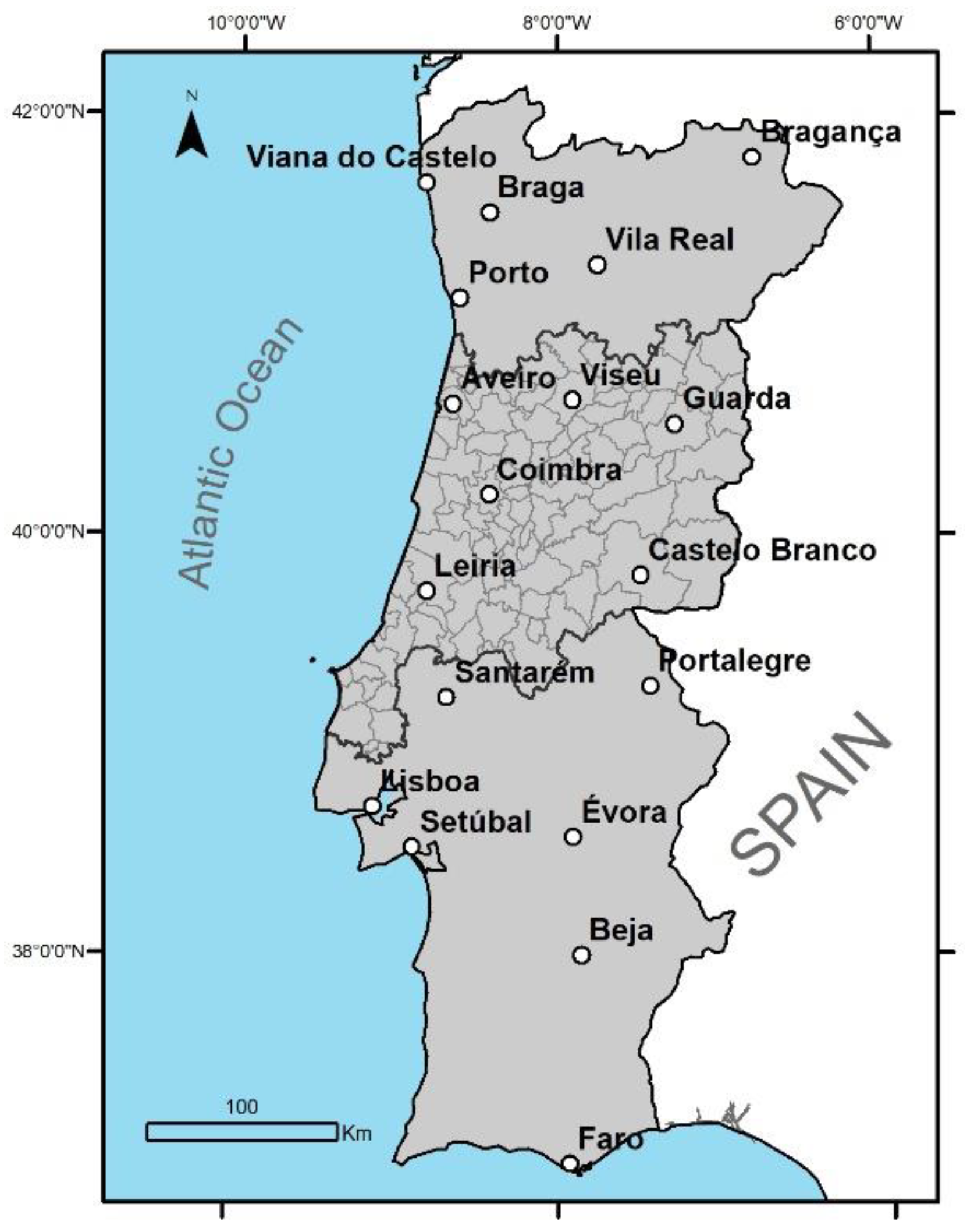
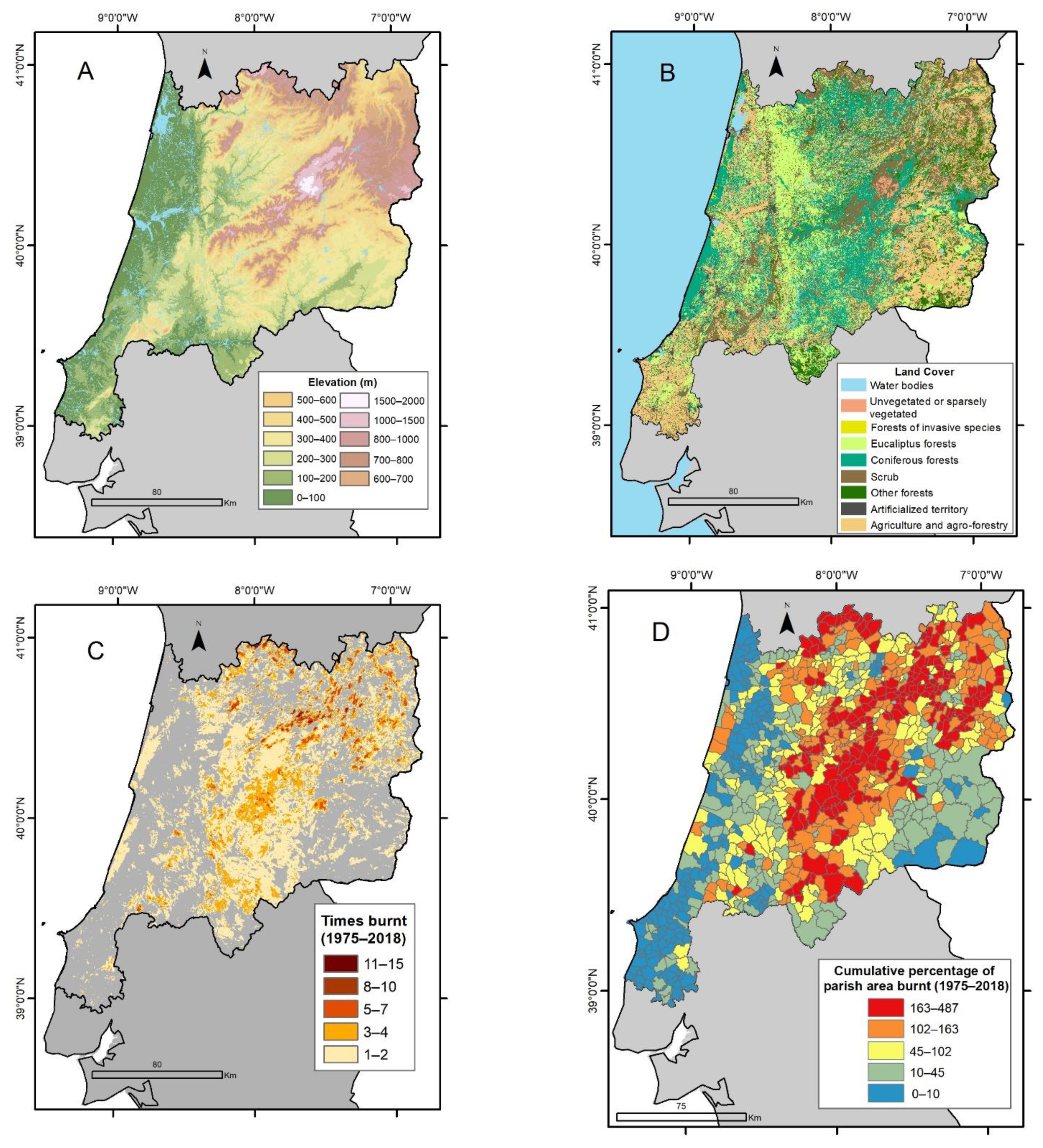
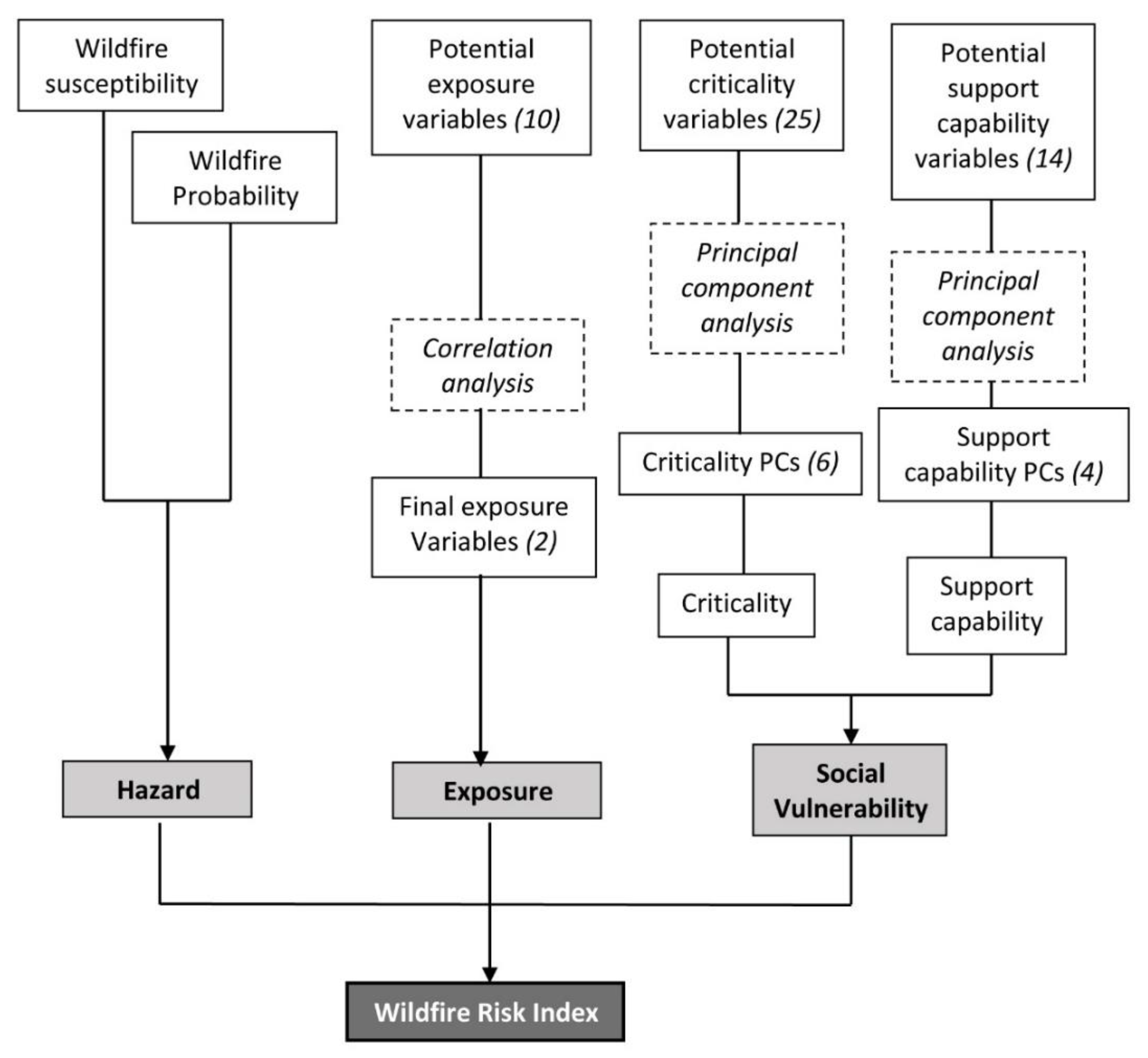

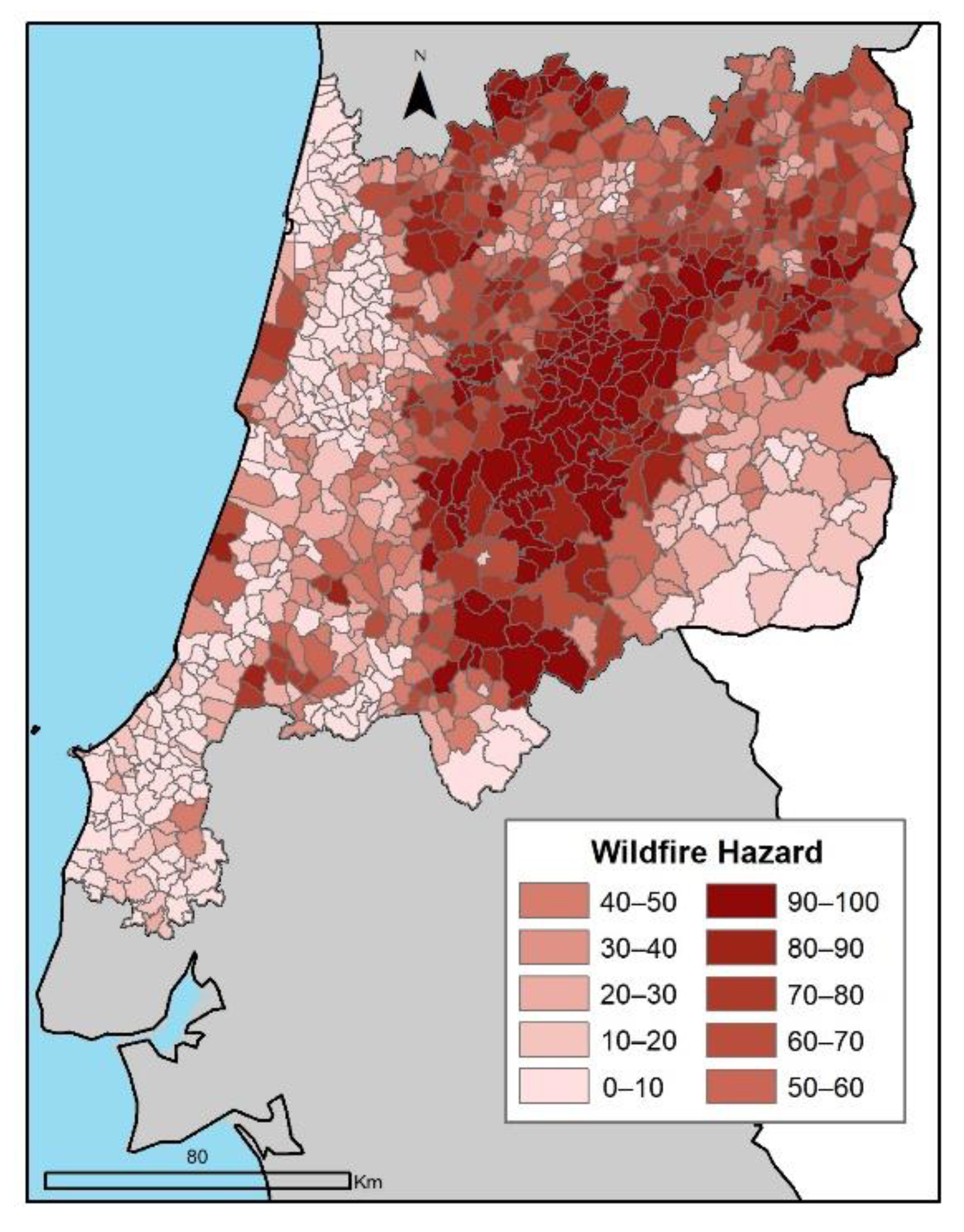
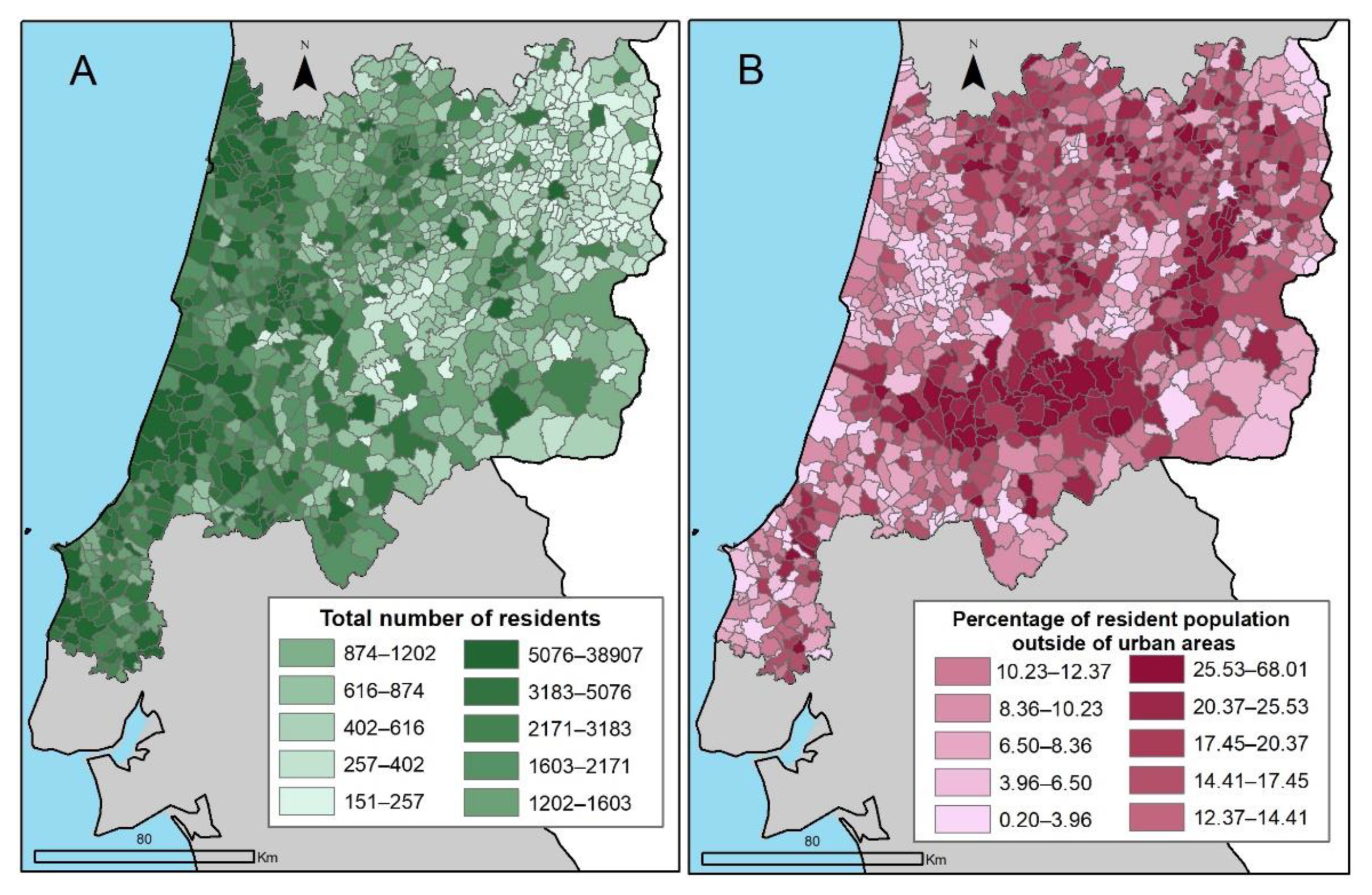
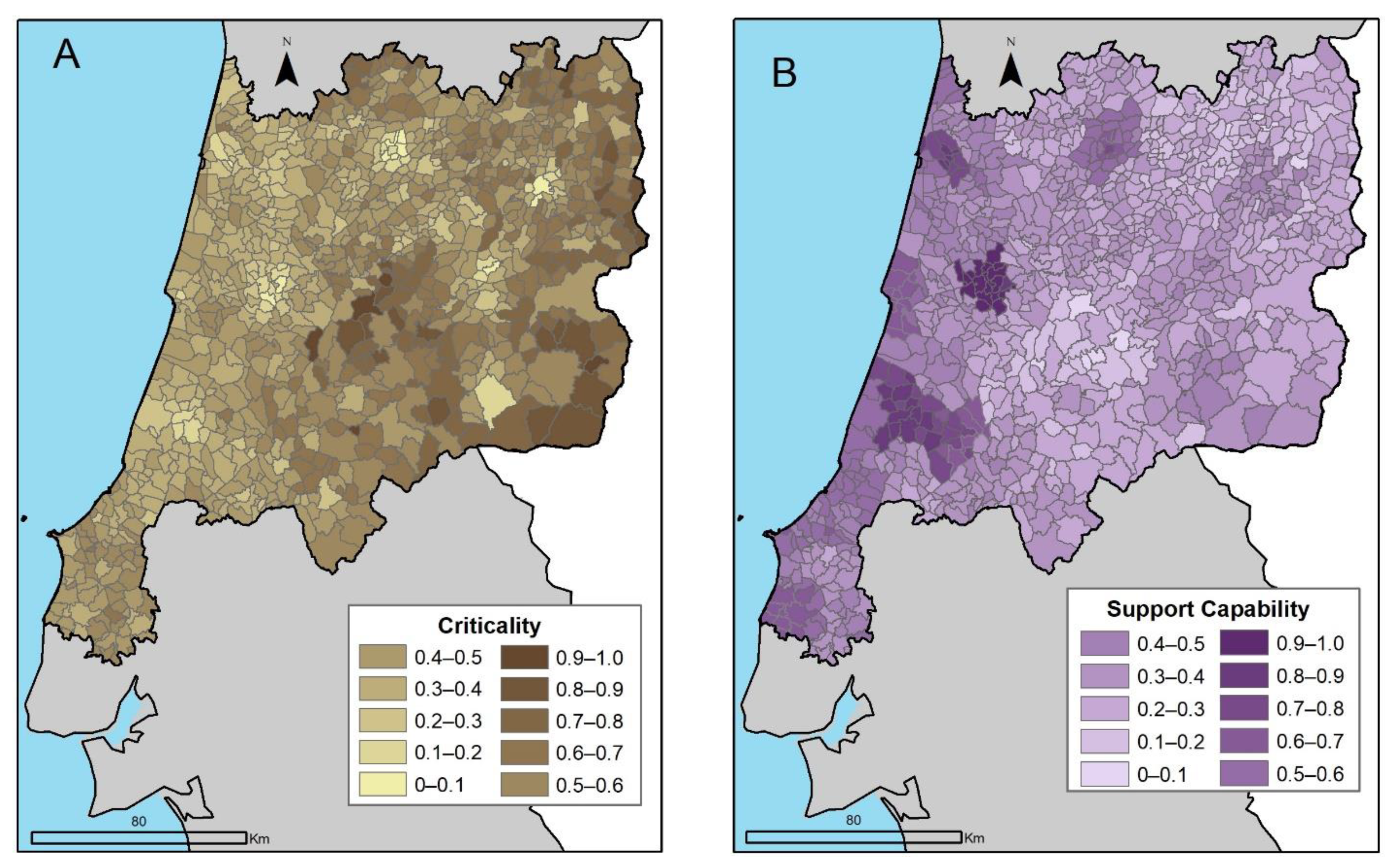
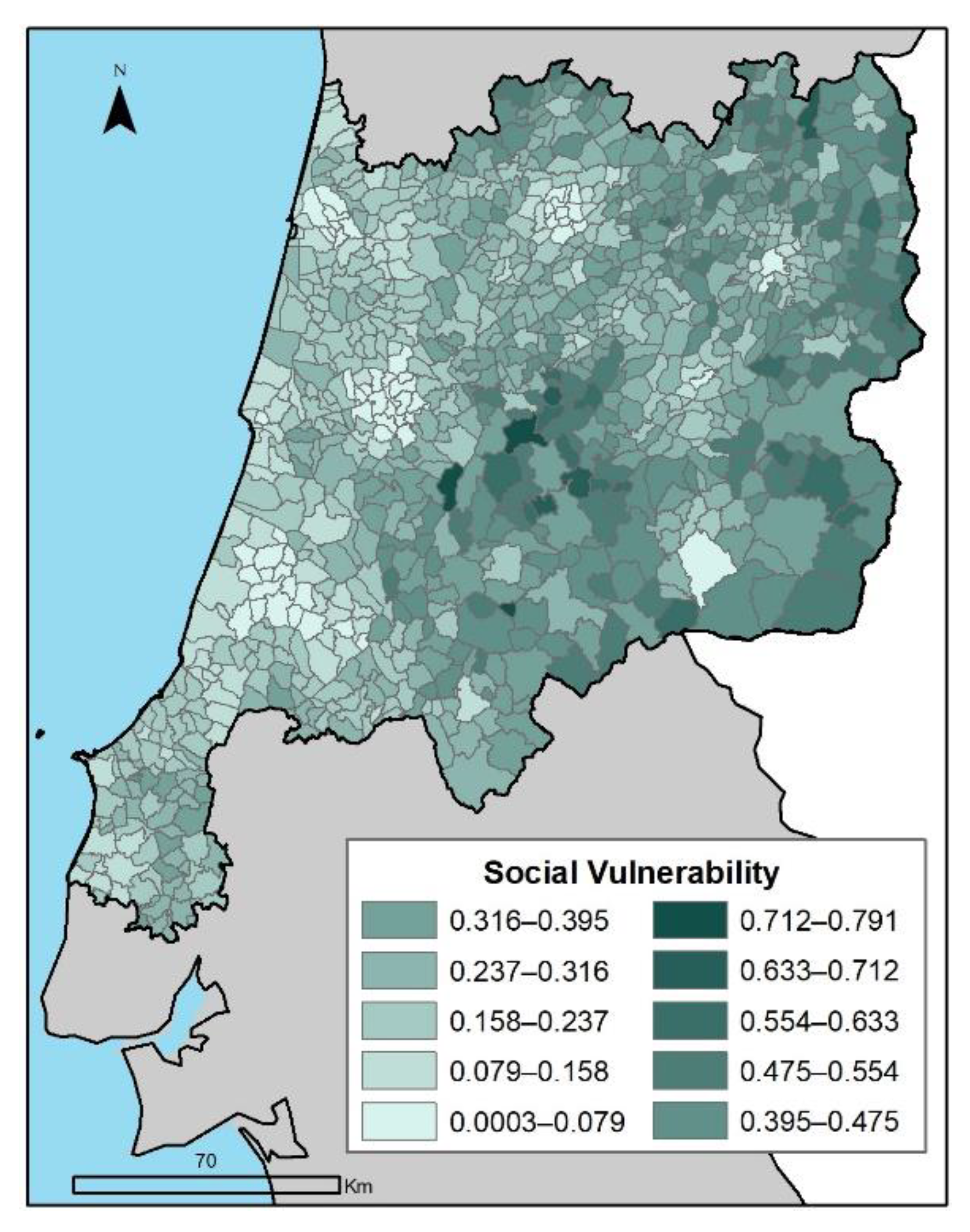
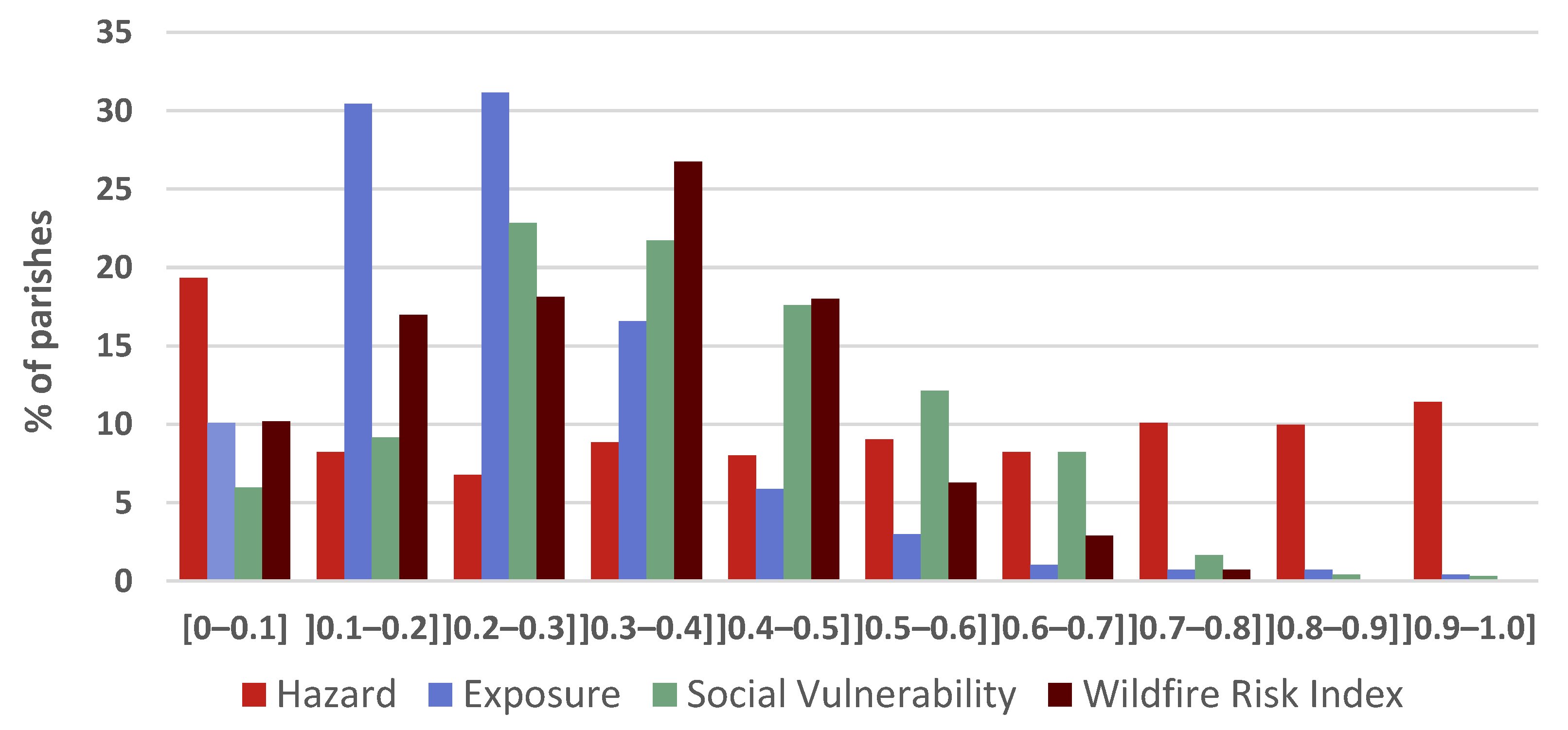
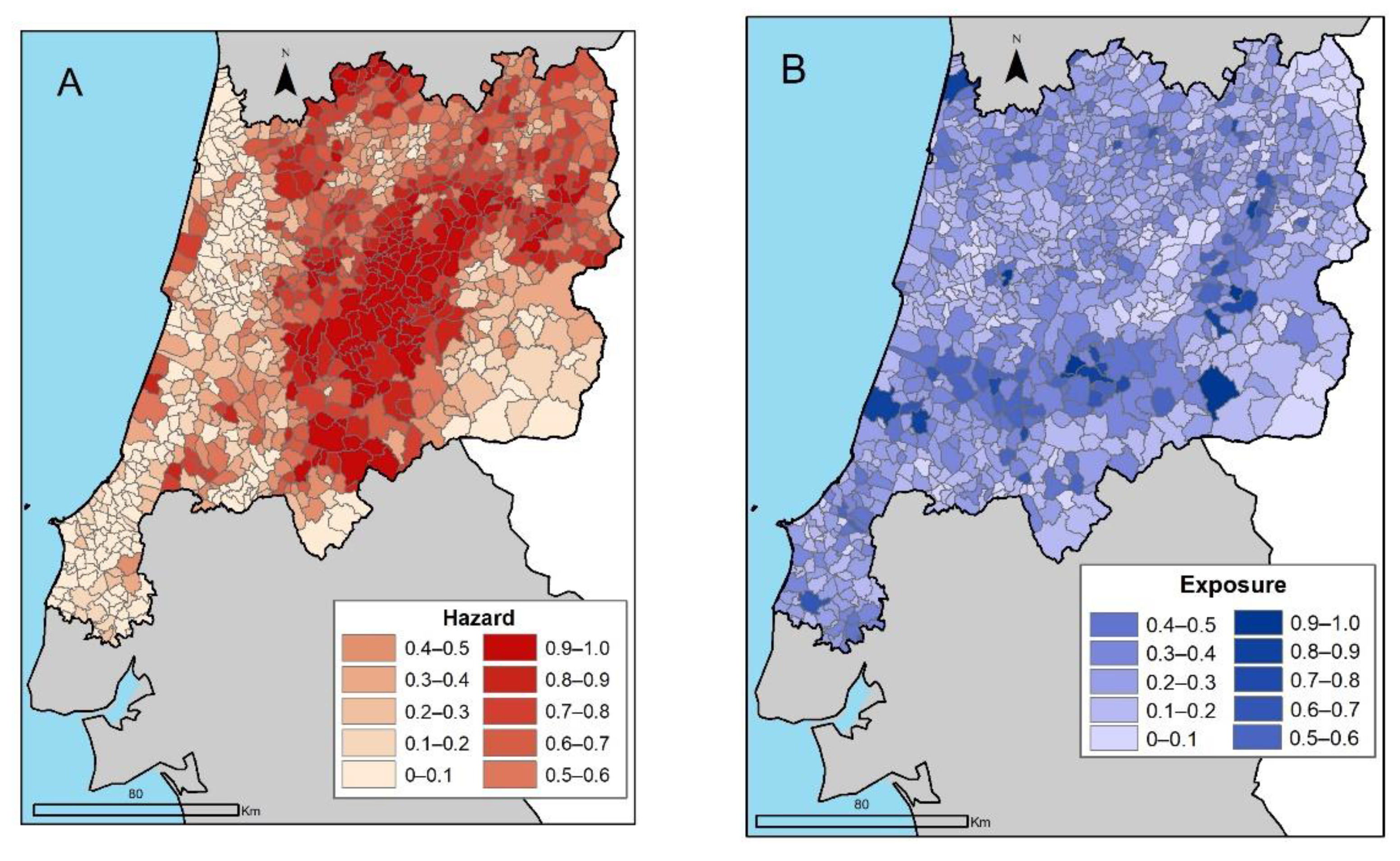

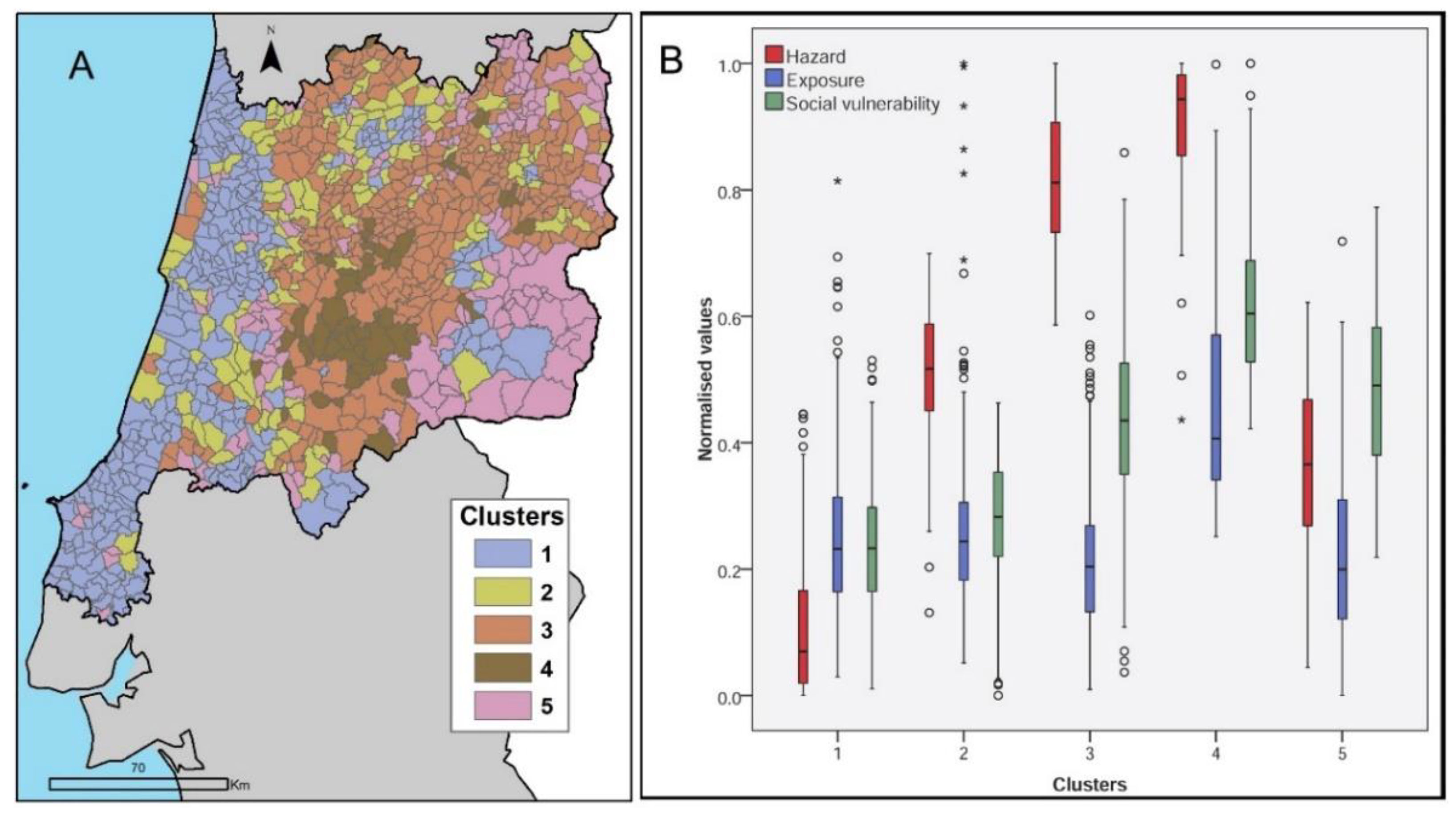
| TotBui | UBui | NUBui | DiffBui | PerNUBui | TotRes | URes | NURes | DiffRes | |
|---|---|---|---|---|---|---|---|---|---|
| TotBui | |||||||||
| UBui | 0.995 ** | ||||||||
| NUBui | 0.596 ** | 0.511 ** | |||||||
| DiffBui | 0.976 ** | 0.993 ** | 0.408 ** | ||||||
| PerNUBui | −0.220 ** | −0.287 ** | 0.410 ** | −0.360 ** | |||||
| TotRes | 0.912 ** | 0.921 ** | 0.435 ** | 0.919 ** | −0.238 ** | ||||
| URes | 0.900 ** | 0.914 ** | 0.394 ** | 0.917 ** | −0.261 ** | 0.999 ** | |||
| NURes | 0.707 ** | 0.640 ** | 0.922 ** | 0.555 ** | 0.242 ** | 0.584 ** | 0.544 ** | ||
| DiffRes | 0.885 ** | 0.903 ** | 0.350 ** | 0.912 ** | −0.284 ** | 0.995 ** | 0.999 ** | 0.499 ** | |
| PerNURes | −0.300 ** | −0.358 ** | 0.289 ** | −0.419 ** | 0.950 ** | −0.318 ** | −0.337 ** | 0.139 ** | −0.357 ** |
| Code | Variable |
|---|---|
| ILLIT | Illiteracy rate (%) |
| UNIVDEG | Proportion of the resident population with university degree (%) |
| SING65 | Proportion of single-member families constituted by people with 65 or more years of age (%) |
| CCHILD | Proportion of lodgings formed by couples with children (%) |
| COMMUT | Mean commuting time of the working or studying resident population (min) |
| RESOTHER5 | Proportion of the resident population that resided in another municipality 5 years before (%) |
| AUTOM | Proportion of the population using automobile for dislocations (%) |
| ---- | School dropout rate (%) |
| ---- | Proportion of the resident population with 14 or less years of age (%) |
| FOREIGN | Proportion of the resident population of foreign nationality (%) |
| FEMACT | Female activity rate (%) |
| AGE | Mean age of resident population (years) |
| WSOTHER | Proportion of the resident population working or studying in another municipality (%) |
| PROFSOCV | Proportion of socially more valued professionals (%) 1 |
| ---- | Female proportion of the population (%) |
| SEASON | Proportion of seasonally used classic family lodgings (%) |
| LACKINF | Proportion of family lodgings lacking at least one basic infrastructure (%) |
| SELFOWN | Proportion of self-owned lodgings that include expenses (%) |
| AGEBUILD | Average age of buildings (years) |
| OVERCR | Proportion of overcrowded lodgings (%) |
| ---- | Proportion of rented or subleased classic lodgings (%) |
| SINGACCO | Proportion of single-lodging buildings (%) |
| BUILT10 | Proportion of buildings built within the previous ten years (%) |
| FLOORS | Floors by building (Nº) |
| ---- | Proportion of non-classical lodgings2(%). |
| Code | Variable | Spatial Scope | Source | Year |
|---|---|---|---|---|
| AGEBUILD | Ageing ratio of buildings (%) | Parish | INE | 2011 |
| WHEELCH | Proportion of buildings having wheelchair accessibility (%) | Parish | INE | 2011 |
| REPDEGR | Proportion of buildings in need of major reparations or very degraded (%) | Parish | INE | 2011 |
| RESOUT | Proportion of the resident population living outside of urban centres (%) | Parish | INE, DGT | 2011 |
| ROAD | Road network density (km/km2) | National | OSM | 2020 |
| ------- | ATM machines (Nº) | Municipality | INE | 2019 |
| ------- | Firefighter corporations (Nº) | Municipality | INE | 2018 |
| FIREF | Firefighters (Nº) | Municipality | INE | 2018 |
| ------- | Pharmacies and mobile pharmaceutical posts (Nº) | Municipality | INE | 2019 |
| NURSES | Nurses by workplace (Nº) | Municipality | INE | 2019 |
| ROOMS | Rooms in tourist accommodation establishments (Nº) | Municipality | INE | 2019 |
| URBWAST | Urban waste collected by inhabitant (kg) | Municipality | INE | 2019 |
| GVA | Gross Value Added of enterprises (EUR) (note: does not include financial sector) | Municipality | INE | 2018 |
| MEDSALEV | Median sale value by m2 of family accommodations | Municipality | INE | 2019 |
| Variable Code | Principal Component | |||||
|---|---|---|---|---|---|---|
| 1 | 2 | 3 | 4 | 5 | 6 | |
| AGE | 0.919 | −0.073 | −0.065 | −0.174 | −0.136 | 0.039 |
| FEMACT | −0.886 | 0.197 | 0.100 | 0.125 | −0.014 | −0.090 |
| CCHILD | −0.864 | 0.016 | −0.069 | 0.176 | 0.143 | −0.045 |
| SING65 | 0.838 | −0.066 | −0.066 | −0.171 | 0.020 | 0.018 |
| SEASON | 0.821 | −0.017 | 0.035 | 0.033 | 0.122 | −0.093 |
| ILLIT | 0.783 | −0.159 | −0.124 | −0.042 | 0.066 | −0.016 |
| SELFOWN | −0.746 | 0.359 | 0.222 | 0.085 | −0.039 | −0.085 |
| AUTOM | −0.541 | −0.049 | −0.009 | 0.123 | −0.453 | −0.023 |
| FLOORS | 0.182 | 0.763 | −0.043 | 0.079 | 0.062 | −0.048 |
| SINGACCO | 0.358 | −0.747 | −0.272 | 0.070 | −0.087 | 0.096 |
| UNIVDEG | −0.556 | 0.686 | 0.212 | 0.048 | −0.174 | −0.041 |
| PROFSOCV | −0.318 | 0.677 | 0.168 | 0.093 | −0.260 | −0.049 |
| RESOTHER5 | 0.084 | 0.144 | 0.836 | 0.121 | −0.087 | 0.173 |
| FOREIGN | −0.187 | 0.138 | 0.761 | −0.038 | 0.131 | −0.109 |
| BUILT10 | −0.168 | 0.057 | 0.114 | 0.863 | 0.090 | 0.044 |
| AGEBUILD | 0.205 | −0.053 | 0.038 | −0.843 | 0.141 | 0.079 |
| OVERCR | −0.264 | −0.072 | 0.161 | 0.014 | 0.805 | −0.049 |
| LACKINF | 0.418 | −0.075 | −0.283 | −0.030 | 0.530 | 0.138 |
| WSOTHER | −0.201 | −0.177 | 0.179 | 0.029 | −0.144 | 0.793 |
| COMMUT | 0.226 | 0.004 | −0.116 | −0.061 | 0.160 | 0.788 |
| Cardinality | + | − | + | − | + | + |
| % Variance explained | 31.176 | 11.813 | 8.405 | 8.149 | 7.016 | 6.825 |
| Variable Code | Principal Component | |||
|---|---|---|---|---|
| 1 | 2 | 3 | 4 | |
| FIREF | 0.878 | −0.18 | −0.019 | 0.000 |
| GVA | 0.858 | 0.21 | −0.084 | −0.115 |
| ROOMS | 0.787 | 0.004 | −0.069 | 0.05 |
| NURSES | 0.762 | 0.196 | 0.100 | −0.071 |
| MEDSALEV | 0.718 | 0.404 | −0.140 | −0.226 |
| URBWAST | 0.137 | 0.787 | −0.173 | 0.195 |
| RESOUT | −0.054 | −0.742 | −0.031 | 0.172 |
| REPDEGR | −0.024 | 0.039 | 0.8 | −0.057 |
| WHEELCH | 0.082 | 0.28 | −0.598 | −0.274 |
| AGEBUILD | 0.01 | 0.066 | 0.176 | 0.848 |
| ROAD | 0.384 | 0.231 | 0.264 | −0.481 |
| Cardinality | + | + | − | − |
| % Variance explained | 30.897 | 14.424 | 10.637 | 10.620 |
Publisher’s Note: MDPI stays neutral with regard to jurisdictional claims in published maps and institutional affiliations. |
© 2022 by the authors. Licensee MDPI, Basel, Switzerland. This article is an open access article distributed under the terms and conditions of the Creative Commons Attribution (CC BY) license (https://creativecommons.org/licenses/by/4.0/).
Share and Cite
Bergonse, R.; Oliveira, S.; Santos, P.; Zêzere, J.L. Wildfire Risk Levels at the Local Scale: Assessing the Relative Influence of Hazard, Exposure, and Social Vulnerability. Fire 2022, 5, 166. https://doi.org/10.3390/fire5050166
Bergonse R, Oliveira S, Santos P, Zêzere JL. Wildfire Risk Levels at the Local Scale: Assessing the Relative Influence of Hazard, Exposure, and Social Vulnerability. Fire. 2022; 5(5):166. https://doi.org/10.3390/fire5050166
Chicago/Turabian StyleBergonse, Rafaello, Sandra Oliveira, Pedro Santos, and José Luís Zêzere. 2022. "Wildfire Risk Levels at the Local Scale: Assessing the Relative Influence of Hazard, Exposure, and Social Vulnerability" Fire 5, no. 5: 166. https://doi.org/10.3390/fire5050166
APA StyleBergonse, R., Oliveira, S., Santos, P., & Zêzere, J. L. (2022). Wildfire Risk Levels at the Local Scale: Assessing the Relative Influence of Hazard, Exposure, and Social Vulnerability. Fire, 5(5), 166. https://doi.org/10.3390/fire5050166








